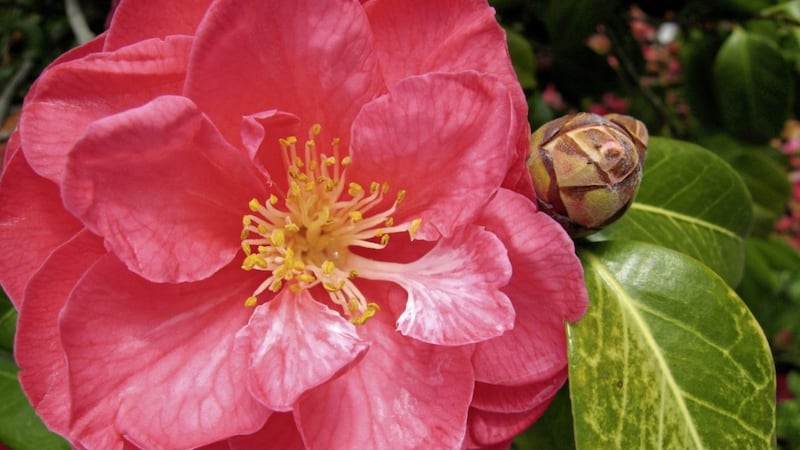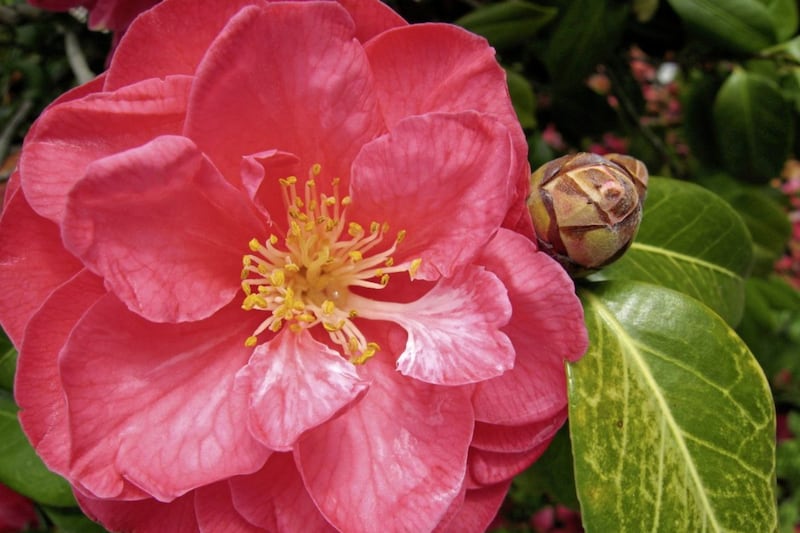EVEN those unacquainted with gardening will likely have an affection for one species of camellia – or at least the beverage brewed from its leaves. Camellia sinensis is the common tea plant, native to the Far East, and the leaves of which this most Irish of drinks is derived.
Camellias are an exotic addition to any garden, adding a splash of winter colour and providing a glimpse of the spring days ahead. They are evergreen, long-flowering shrubs and small trees with long, dark green, glossy leaves. There are about 80 species of camellias, all from south-eastern Asia.
The flowers resemble those of roses – large and conspicuous – sometimes reaching 12 inches in diameter. Colours range from white to purple or red, depending on variety. Camellia japonica 'Lady Campbell' for example, has large, prolific, bright red flowers. Many species of camellia bloom in the period from February to May, but there are also hardy autumn flowering varieties too.
The fragrant, double-flowered pink Camellia 'Ashton's Ballethas’ is in its glory from October to December whereas the bright pink flowered Camellia 'Sugar' blooms from November to January.
Camellia prefer a slightly acidic soil with plenty of humus. Because they look so lush and tropical, people tend to situate them in the most sheltered places. In principle this is correct, but not every sheltered spot is suitable. For example, camellia won’t perform to its very best on a south-facing wall, even though intuitively you might think this is ideal. In fact, the buds benefit from being kept cool.
A partially shaded position is probably the best situation, ideally away from early morning sun. If buds warm up too quickly after frost they can drop off, meaning no flowers. Camellias are great when grown with companion plants around their base. Plant Pulmonaria, Helleborus niger (Christmas rose) or Gallanthus (snowdrops) with them, all of which will flower around the same time and look fabulous underneath.
But remember Camellia japonica is a surface-rooting plant so it is important not to hoe or otherwise disturb the surface immediately around the plant.
Camellias grow about 15-20 inches per year. Prune carefully after flowering, to maintain shape, if required. The plant does not need to be pruned for its own good. Make sure soil is kept moist in dry summer conditions and feed half way through summer with potassium-rich fertiliser.
Water well after feeding but use rainwater rather than tap water, which may contain lime. As ericaceous plants, camellias hate lime. Protect from cold winds and frost. If low temperatures are forecast for a prolonged period, cover your camellia with horticultural fleece, readily available from any garden centre.
If you’re not quick enough with the horticultural fleece, frost damage may cause camellias to lose some of their leaves, but don’t panic, in the course of the year the plant will recover, especially if you can move it to a sheltered spot (pot grown plants).
Those camellia species that are not quite hardy will do extremely well in pots, if you move them in and out of a conservatory or greenhouse when frost threatens. Rather than putting your plant through all the stress of re-potting, it’s better to provide a bit more food to the plant and top up the compost with humus rich topsoil.
Reduce watering of pot-grown camellias to once a week in autumn and once a month in winter. In the spring, gradually increase watering as temperatures rise and day length increases.



